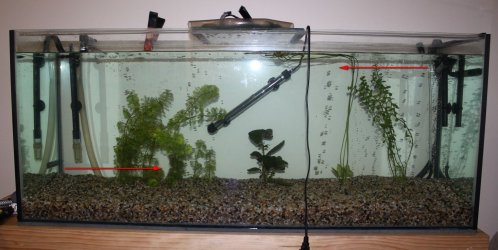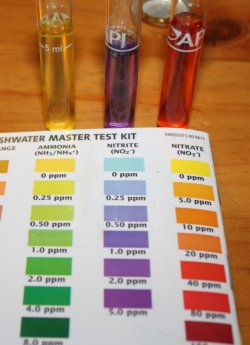Yande
New Member
Hi All, this is my second tank.
It's 1.2m Long x .35m Wide x .5m High.
Around 4' Long x 1.1ft wide x 1.6ft High.
Aprrox 200 L or 50 Gallon.
As it has worked out, I have 2 Cannister filters, which combined (state) that they can service a 200 liter (50G) tank.
If you check my pictures, you can see the setup I thought would work best. Red Arrows show proposed water flow. It is a deep narrow tank, so, to get the water moving, 2 filter outlets, inlets at each end, one on top, one below the water line. Is this crazy or just common sense?
Bubbles are only there to assist with the cycle, and inlet and outlets are only positioned temporarily at the moment. As we live on the Coast, in the country, tomorrow we are going searching for some freshwater driftwood to assist in decreasing the Ph, which is around 7.6 and for the aesthetics. Perhaps a rock or two also. We have Granite near by. From which the Sydney Harbour bridge was actually built from. Suitable?
Cannisters are Fluval 106 and a Aquasyncro AE60 both of which I have loaded with Cermedia as well as other filtration mediums. Noth are cheap EBay filters.
To be honest, we have not decided on what fish to add, though are thinking of adding a couple of guppies, (+) to start the tank off. Have a likeing to Angel, Dollar Fish, though have not searched the necessary parameters of each of these. I will come back to ask more.
Chems are pretty well through the roof?? Been using Dr Tims Ammonia and Stability to make the cycle happen. Fishless.
Any advice on my bi-filtration set up would be appreciated, also, with regards the chems, considering the pic, when would you advise adding fish? Couple of days?
We all got to start somewhere. Thanks
It's 1.2m Long x .35m Wide x .5m High.
Around 4' Long x 1.1ft wide x 1.6ft High.
Aprrox 200 L or 50 Gallon.
As it has worked out, I have 2 Cannister filters, which combined (state) that they can service a 200 liter (50G) tank.
If you check my pictures, you can see the setup I thought would work best. Red Arrows show proposed water flow. It is a deep narrow tank, so, to get the water moving, 2 filter outlets, inlets at each end, one on top, one below the water line. Is this crazy or just common sense?
Bubbles are only there to assist with the cycle, and inlet and outlets are only positioned temporarily at the moment. As we live on the Coast, in the country, tomorrow we are going searching for some freshwater driftwood to assist in decreasing the Ph, which is around 7.6 and for the aesthetics. Perhaps a rock or two also. We have Granite near by. From which the Sydney Harbour bridge was actually built from. Suitable?
Cannisters are Fluval 106 and a Aquasyncro AE60 both of which I have loaded with Cermedia as well as other filtration mediums. Noth are cheap EBay filters.
To be honest, we have not decided on what fish to add, though are thinking of adding a couple of guppies, (+) to start the tank off. Have a likeing to Angel, Dollar Fish, though have not searched the necessary parameters of each of these. I will come back to ask more.
Chems are pretty well through the roof?? Been using Dr Tims Ammonia and Stability to make the cycle happen. Fishless.
Any advice on my bi-filtration set up would be appreciated, also, with regards the chems, considering the pic, when would you advise adding fish? Couple of days?
We all got to start somewhere. Thanks




 ) That's not necessary, but I wanted some extra flow and my species could handle the extra - actually the neon tetras would jump into the outflow of the water pump like it was a treadmill... the entire shoal and just swim against the full strength of the current for minutes at a time. Then, they'd move off and find some other areas to check out.
) That's not necessary, but I wanted some extra flow and my species could handle the extra - actually the neon tetras would jump into the outflow of the water pump like it was a treadmill... the entire shoal and just swim against the full strength of the current for minutes at a time. Then, they'd move off and find some other areas to check out.
